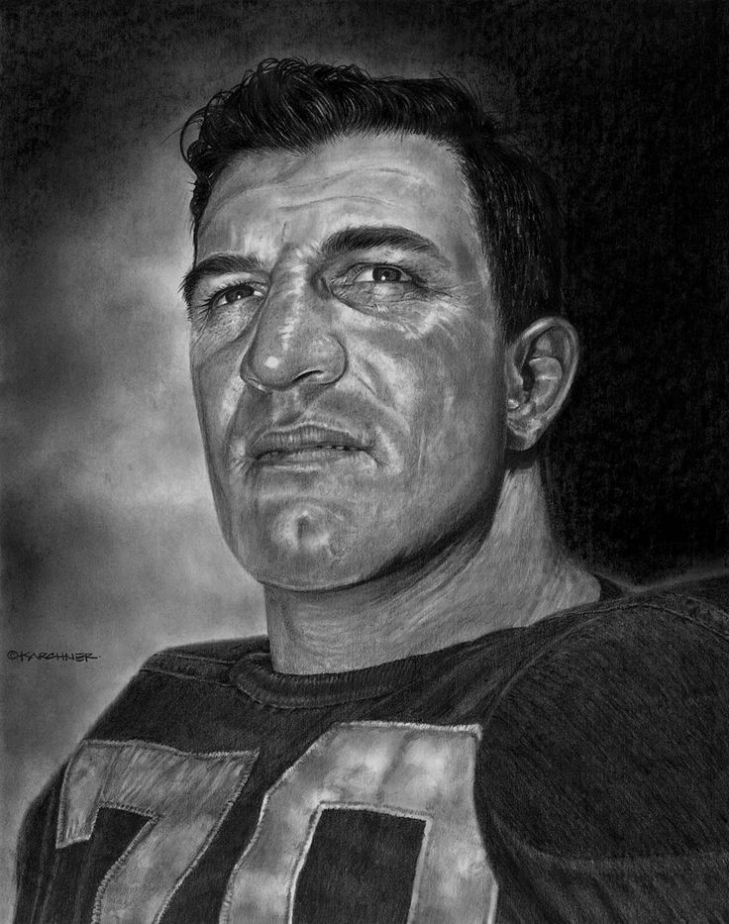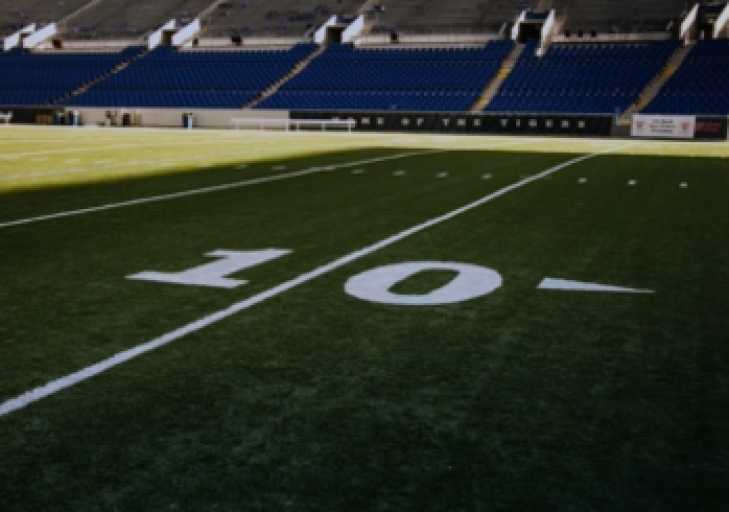
Committee Chairman
The Pro Football Hall of Fame Revisited Project: 1969 Preliminary VOTE
1969 PRELIMINARY RESULTS:
Thank you to all who participated in the Pro Football Hall of Fame Revisited Project. If you are still determining what that is, we acted like the PFHOF had its first class in January 1946.
We have completed the first 23 years thus far.
For “1969,” a Preliminary Vote with close to 100 players whose playing career ended by 1959. We are also following the structure in that players have 20 years of eligibility, and if they do not make it into the Hall, they are relegated to the Senior Pool.
Each voter was asked to select 25 names from the preliminary list, and the top 25 vote-getters were named Semi-Finalists.
A week later, the voters will be asked to pick 15 names from the 25 Semi-Finalists, and next after, they will pick five from the remaining 15. We will continue this process weekly until we catch up to the current year.
Please note that a significant change occurred “years ago,” allowing voters to submit less than the allotted spots.
30 Votes took place.
This is for the “Modern Era”
Bold indicates they advanced to the Semi-Finals:
*Indicates they have been removed from future ballots.
|
Player |
Year of Eligibility |
Vote Total |
|
Joe Perry FB |
1 |
27 |
|
Bob St. Clair T |
1 |
26 |
|
Ernie Stautner DT-DE-G |
1 |
26 |
|
Mike McCormack T-G |
2 |
23 |
|
Charlie Conerly QB |
3 |
21 |
|
Leo Nomellini DT-T |
1 |
21 |
|
Pat Harder E |
11 |
20 |
|
Alan Ameche FB |
4 |
20 |
|
Marshall Goldberg FB |
16 |
19 |
|
Gene Lipscomb DT |
2 |
19 |
|
Les Richter LB-C |
2 |
18 |
|
Ward Cuff WB-QB-HB |
17 |
17 |
|
Bill Osmanski FB |
17 |
17 |
|
Vic Sears T-DT |
11 |
17 |
|
Tank Younger FB-LB-HB |
6 |
17 |
|
Billy Wilson E-FL |
4 |
17 |
|
Billy Howton E-Fl |
1 |
17 |
|
Bruno Banducci G |
10 |
15 |
|
Woody Strode E |
15 |
13 |
|
Harlon Hill E-DB |
2 |
13 |
|
Les Bingaman DG-G-C |
10 |
13 |
|
Buckets Goldenberg G-BB |
19 |
12 |
|
Frankie Albert QB |
12 |
11 |
|
Bucko Kilroy G-MG-T-DT |
9 |
10 |
|
Charley Brock C-HB |
17 |
9 |
|
Frank Cope T |
17 |
8 |
|
George Wilson E |
18 |
7 |
|
Walt Michaels LB |
1 |
7 |
|
Spec Sanders TB |
14 |
6 |
|
Bobby Walston E-HB-K |
2 |
5 |
|
Kyle Rote E-HB |
3 |
5 |
|
Duane Putnam G |
2 |
5 |
|
Pug Manders HB-TB |
17 |
4 |
|
Marion Campbell DE-DT-MG-G-T |
3 |
4 |
|
Ray Renfro HB-FL |
1 |
4 |
|
Baby Ray T |
16 |
3 |
|
Hugh Taylor QB |
10 |
3 |
|
Leon Hart E-FB-DE |
7 |
3 |
|
Abe Gibron G |
5 |
3 |
|
Pete Tinsley G |
19 |
2 |
|
Parker Hall TB-HB |
18 |
2 |
|
Paul Christman QB |
14 |
2 |
|
Tommy Thompson QB |
14 |
2 |
|
Buster Ramsey G |
13 |
2 |
|
Ray Bray G |
12 |
2 |
|
Paul Lipscomb T-DT |
10 |
2 |
|
George Ratterman QB |
8 |
2 |
|
Johnny Olszewski DB-HB |
2 |
2 |
|
Ray Wietcha C |
2 |
2 |
|
Bob Masterson E |
18 |
1 |
|
Jim Lee Howell E |
17 |
1 |
|
Chet Bulger T |
14 |
1 |
|
Ted Frisch FB |
14 |
1 |
|
Dick Huffman T |
14 |
1 |
|
Bill Fischer T-G-DT |
11 |
1 |
|
Bob Boyd E-DE |
7 |
1 |
|
Jim David DB S |
5 |
1 |
|
Dale Dodrill MG-LB |
5 |
1 |
|
Chuck Drazenovich LB-FB |
5 |
1 |
|
Hardy Brown LB-DB-FB |
4 |
1 |
|
Woodley Lewis DB-E |
4 |
1 |
|
Art Spinney G-DE |
4 |
1 |
|
Tom Brookshier DB |
3 |
1 |
|
*Dick Hoerner E |
12 |
0 |
|
Dub Jones B-DB-WB-TB |
9 |
0 |
|
George Taliaferro HB-TB-QB-DB |
9 |
0 |
|
*Bill Johnson C-LB |
8 |
0 |
|
Warren Lahr DB |
5 |
0 |
|
*Ray Mathews HB-E-FL |
4 |
0 |
|
Jim Mutscheller E-DE |
3 |
0 |
|
Will Sharman DB |
3 |
0 |
|
*Leo Sugar DE |
2 |
0 |
|
Harley Sewell G |
1 |
0 |
This is for the “Senior Era”
Bold indicates they advanced to the Semi-Finals:
*Indicates that they will be removed from the ballot permanently.
|
Player |
Year |
Votes |
|
George Christensen |
6 |
16 |
|
Al Nesser |
12 |
15 |
|
Whizzer White |
3 |
15 |
|
Ace Gutkowski |
5 |
12 |
|
Joey Sterneman |
14 |
9 |
|
George Svendesen |
3 |
9 |
|
Wildcat Wilson |
15 |
8 |
|
Joe Kopcha |
8 |
7 |
|
Gus Sonnenberg |
14 |
6 |
|
Cub Buck |
19 |
5 |
|
Gaynell Tinsley |
4 |
5 |
|
Father Lumpkin |
7 |
4 |
|
Jack Manders |
4 |
4 |
|
Glenn Presnell |
8 |
3 |
Please note that three voted for “None of the Above.”
We also had another vote where the voters were asked how they wanted to keep voting parameters over the next few years. 16 of 30 stated that you want to keep it as is, where YOU MUST obtain 50 percent of the vote to enter the Pro Football Hall of Fame Revisited Project.
Next week, we will announce the Semi-Finalists for the 1969 Pro Football Hall of Fame Revisited Project.
Controversial NFL Hall of Fame Inductions: Legends or Lucky?
Key Takeaways
- Controversial inductions often arise when a player's fame outweighs their stats.
- The selection process can be muddled by unclear criteria and a lack of diversity.
- Era differences and biases can affect who gets in and who doesn't.
- Public perception plays a significant role in how these decisions are viewed.
Controversial NFL Hall of Fame Inductions: Are They Justified?
What makes an induction controversial? Typically, it's when a player's fame or a single memorable moment seems to overshadow their overall career performance. The Hall of Fame selection committee uses specific criteria, but sometimes personal biases and historical context can cloud these judgments.
Notable Controversial Inductions Based on Statistics and Performance
Joe Namath
Joe Namath is a classic example. His career stats—a 62-63-4 record, 50.1% completion rate, 173 touchdowns, and 220 interceptions—are not Hall of Fame material by today's standards. Yet, his bold guarantee and victory in Super Bowl III left an indelible mark on NFL history. Was it fame over skill?
Art Monk
Art Monk's induction also raises eyebrows. While his career was long and productive, his three Pro Bowl appearances seem low for a Hall of Famer. His success in three Super Bowls likely helped his case. But should longevity alone earn a spot in Canton?
Bob Hayes
Bob Hayes had blinding speed and early success but didn't sustain it. His 371 receptions and 71 touchdowns are modest compared to other Hall of Fame receivers. Did his early career brilliance and a Super Bowl win overshadow his later years?
Lynn Swann
Lynn Swann dazzled in the Super Bowl, but his career stats—336 receptions, 5,462 yards, and 51 touchdowns—don't scream Hall of Fame. His induction is a testament to the weight of Super Bowl performances. But is it fair to prioritize a few games over a whole career?
Issues with the Selection Process
Diversity in the Selection Committee
The selection committee's makeup can influence who gets inducted. More diversity, including former players and coaches, could bring varied perspectives and reduce biases. Wouldn't a broader committee better reflect the game's history?
Clear Criteria for Selection
A standardized framework for evaluating candidates could help. Clear criteria would make it easier to judge who truly deserves a spot in the Hall. Shouldn't there be a more transparent process?
Backlog of Deserving Players
Many players wait years for induction, creating a backlog. Positions like wide receiver are particularly crowded. Could clearer criteria help speed up this process?
Senior Nominees and Their Controversies
Chris Hanburger
Chris Hanburger's induction as a senior nominee came after years of being overlooked. With nine Pro Bowl appearances, his career was solid, but not outstanding. Was his senior nomination fair, or did it bypass the usual scrutiny?
Roger Wehrli
Roger Wehrli's case is similar. He wasn't seen as elite during his career, yet he made it as a senior nominee. Does his induction highlight flaws in the senior nomination process?
Coaches and Contributors: A Different Standard
Dick LeBeau
Dick LeBeau is known more for his coaching prowess than his playing days. With 62 interceptions, his playing stats are respectable but not extraordinary. Should his coaching success have been the main factor for his induction?
Marty Schottenheimer
Marty Schottenheimer's exclusion is puzzling. Despite a successful coaching career, he remains outside the Hall. Does his absence highlight inconsistencies in how coaches and contributors are evaluated?
Historical Context and Performance in Different Eras
Era Considerations
Players from different eras face varying standards. What was considered great decades ago might not hold up today. How do we fairly compare players from different times?
Super Bowl Era Bias
Some players from the Super Bowl era were overlooked initially but later inducted as seniors. Does this reflect a bias towards more recent players?
Notable Snubs and Their Impact
Steve Smith Sr.
Steve Smith Sr. boasts impressive stats and longevity, yet he remains snubbed. Is there a bias against certain positions or players from less successful teams?
Willie Anderson
Willie Anderson was a top offensive tackle but played on underperforming teams. How much should team success influence individual recognition?
Randy Gradishar
Randy Gradishar waited 35 years for induction despite a stellar career. Does his long wait reflect broader issues in the selection process?
Torry Holt
Torry Holt's continued snubbing is baffling given his strong career stats. What more does he need to prove his worthiness?
Public and Media Perception
Many Hall of Fame decisions face public and media dissent. Fans often debate the worthiness of inductees, highlighting the subjective nature of these selections. Are fans' voices being heard enough?
Subjective Nature of Selections
Opinions on player worthiness vary widely. How can the Hall of Fame balance these differing views to maintain its credibility?
Betting Lines and Hall of Fame Predictions
With the ongoing debate over who truly deserves a spot in Canton, many fans and analysts turn to metrics and predictive odds, much like those seen in FanDuel lines. These betting lines often reflect public sentiment, highlighting the players whose legacies resonate most with fans and bettors alike.
Just as in sports betting, where stats, standout moments, and subjective factors impact odds, the Hall of Fame selection process mirrors this balance of data and emotion—keeping fans invested in the ever-evolving Hall of Fame discussions.
Conclusion
Controversial inductions spark debate and keep the NFL Hall of Fame in the spotlight. They challenge us to consider what truly makes a player legendary. As the Hall evolves, will it find a way to balance fame, stats, and historical impact more effectively?
How to Move the Things That Hold Our Greatest Memories
When we think about moving, the focus often falls on logistics—packing boxes, organizing, and ensuring everything makes it to the new location safely. However, some items in our homes carry far more than just physical weight; they hold memories, emotions, and connections to the past. From family heirlooms to sports memorabilia, vintage records, and treasured trophies, these are the things that define our personal history. Ensuring these items are moved with care is not just about avoiding damage but about preserving the stories and moments they represent. Here's how to move the things that hold our greatest memories with the respect they deserve.
- Plan Ahead and Take Inventory
The first step in moving meaningful possessions is to plan ahead. Create a detailed inventory of all the items that have sentimental value. This includes everything from framed photos, awards, sports memorabilia, and vintage collections to family keepsakes passed down through generations.
By documenting each piece, you'll not only be more organized during the move but you'll also be able to prioritize which items require the most protection. Take photographs of each item before packing to ensure you have a visual record of their condition, which can be especially helpful if you're hiring professional movers or filing insurance claims.
- Pack with Care
Packing items that hold your greatest memories is different from packing everyday items. Take your time with each piece, handling it gently and ensuring it's protected from every angle. If you're moving framed items, place corner protectors on each frame to avoid damage, and be sure to pack them upright to minimize pressure on the glass.
When it comes to sports memorabilia—like signed jerseys, balls, or equipment—use airtight containers to keep dust, moisture, and dirt from compromising their condition. For vintage collectibles like records, comic books, or trading cards, protective sleeves or cases are essential to preserve their value.
- Hire Professionals for Special Items
For particularly valuable or fragile items, hiring professional movers who specialize in handling delicate possessions is often a wise choice. Many moving companies offer specialty services for items such as musical instruments, sports equipment, and antiques. These experts know how to transport high-value items safely and securely, ensuring they arrive at your new home in the same condition as when they left.
Services like www.shiply.com are especially helpful when moving fragile or high-value items. They connect you with trusted movers who understand the specific needs of handling valuable items, from sports memorabilia to antique furniture, making sure they are transported with utmost care and precision.
In some cases, moving companies can even provide climate-controlled transportation, which is crucial for items sensitive to temperature and humidity changes, like vintage clothing, rare books, or sports memorabilia.
- Ensure Items Are Insured
While it's difficult to put a price on items that hold sentimental value, it's important to ensure they are protected financially during the move. Whether you're transporting a signed Hall of Fame jersey or a family heirloom that's been passed down for generations, check with your insurance provider to see if these items are covered during the move. If they're not, you may need to purchase additional moving insurance specifically for high-value possessions.
Taking this step offers peace of mind, knowing that even in the event of an accident, you have a backup plan to repair or replace items that may get damaged.
- Keep Sentimental Items Close
For smaller, especially meaningful items—like your first baseball glove, a trophy from a major achievement, or a keepsake from a historic sports event—you may want to keep them with you during the move. Pack these items in a separate, clearly marked box and transport them in your own vehicle rather than in the moving truck. By keeping your most cherished items close, you'll reduce the anxiety that can come with entrusting them to others.
This also applies to personal memorabilia such as family photo albums or scrapbooks. These are the items that cannot be replaced, making it essential to give them extra attention and care during the move.
- Unpack Mindfully
Unpacking treasured items requires the same level of care as packing them. Set aside a quiet time to unpack these special items first so you can ensure they are placed in a safe spot in your new home. As you unpack each item, inspect it to make sure it hasn't been damaged in transit.
When deciding where to place these cherished possessions in your new space, think about how they'll be displayed. Incorporating these items into your new home will help you feel more connected to the space, allowing your memories to live on and creating a new chapter for these cherished objects.
Conclusion
Moving the things that hold your greatest memories is more than just transporting objects—it's about safeguarding the moments and experiences that shaped your life. With careful planning, proper packing techniques, and a thoughtful approach, you can ensure that your most treasured items make the journey safely to your new home. These items represent your personal history, and by moving them with care, you preserve not just the physical items but the priceless memories they hold.
Trends in UK Online Casino Sponsorships for 2024
Within the last ten years, there has been an increased growth of online casino sponsorships in tandem with the growth in the online gambling industry. Online casinos started shifting to the sports and entertainment sectors as giant arenas that could present them with opportunities to increase their visibility and reach to consumers.
These sponsorships are undergoing changes in 2024: shifting regulations, changing consumer behaviors, and emerging technologies.
The Increasing Influence of Online Casinos in Sponsorship
One thing that stands out in the trends of 2024 is how online casino sponsorships seem to be booming within mainstream sports and entertainment events. As digital platforms continue to grow, online casinos will find new ways to include their brand in all live sports broadcasts, esports tournaments, and even music festivals.
The exposure that such partnerships give online casinos helps them attract a large demographic, a digitally savvy youth demographic who is no stranger to mobile gaming apps. Other strategic moves to bypass restrictions on advertising have been the involvement of online casinos in key sponsorship deals.
While regulators begin to rein in tightly on direct advertising, sponsorship is another avenue through which casinos can maintain their brand presence and reach out to fans through indirect but highly effective means.
Shifting Regulations and Their Impact
In 2024, regulatory frameworks have changed, creating both challenges and opportunities for development. The rigid rules associated with the practice of advertising, particularly sports events, made online casinos reconsider their approach to sponsorship.
The UK Gambling Commission has issued updated policies aimed at ensuring responsible gambling and protection for vulnerable people. Online casinos focus on promoting safer gambling messages through their sponsorship activity, being transparent in this respect and taking care of players.
Apart from that, some leagues and associations followed the sponsorship methodology that added ethics to choosing sponsorship from companies that advocate for responsible gaming. It guided them to choose casinos as sponsors, where social responsibility would be a major determinant in giving out lucrative sponsorships deals.
Expansion Beyond Traditional Sports
While football has long been considered the favorite sport when it comes to sponsorship by online casinos, 2024 saw a huge expansion into other fields. One of the biggest growth areas is esports. With its global fan base and younger demographic, esports offers another important demographic to online casinos.
Of late, it has become familiar to sponsor esports teams, tournaments, and streaming platforms—opening casinos to a very tech-savvy audience that can be more easily introduced to digital entertainment services.
Despite this, online casino sponsorship further covers entertainment events in the form of music festivals, concerts, and famous YouTube channels. Other sponsorship platforms give casinos the opportunity to go above the sports sphere to other market segments and have wider brand awareness in other arenas.
Technology's Role in Enhancing Sponsorships
This is another of the trends of new technologies, including AI, data analytics, and virtual reality, which outline how sponsorships will be structured and delivered. Online casinos have increasingly sought to capitalize on this trend in their own quest to create innovative and immersive experiences for audiences.
AI-driven algorithms allow casinos to tailor content to individual preferences, ensuring their messages hit and touch exactly the right audience at exactly the right times. Virtual and augmented reality continues to play a role in raising engagement about sponsorships.
Some casinos test virtual sponsorships in the metaverse or even offer live virtual events where entertainment melds with wagering experiences. This is the tech-heavy way of allowing the increase in visibility of casino brands themselves, all while allowing for new, more engaging ways for fans to interact with sponsors.
Growing Focus on Player Engagement and Loyalty
Another trend that will shape online casino sponsorships in 2024 is a focus on player engagement and loyalty. Many online casinos treat sponsorships as extensions of more comprehensive loyalty schemes, offering special benefits for fans who interact with their sponsored content.
Whether this involves providing VIP access to events, personalized gaming sessions, or bespoke merchandise, casinos use such strategic partnerships as a means of engaging their clientele in new ways.
These initiatives build community and brand loyalty for both the sponsor and the sponsored through such an initiative.
In Closing
As a result, online casino sponsorships enter a new exciting phase in the UK in 2024, driven by changes in regulation around technology and an increasing focus on player engagement.
This diversifies the landscape, and it gets tougher; casinos try to think of creative ways to stay in sports and entertainment while serving the greater good for responsible gambling.
From esports to music festivals and from virtual reality, the trends that cut a mold for the industry in 2024 go far beyond and deeper into the core of everyday entertainment. Successful adaptation to new regulations and the creative deployment of state-of-the-art technology to interface with crowds will define a successful casino.





